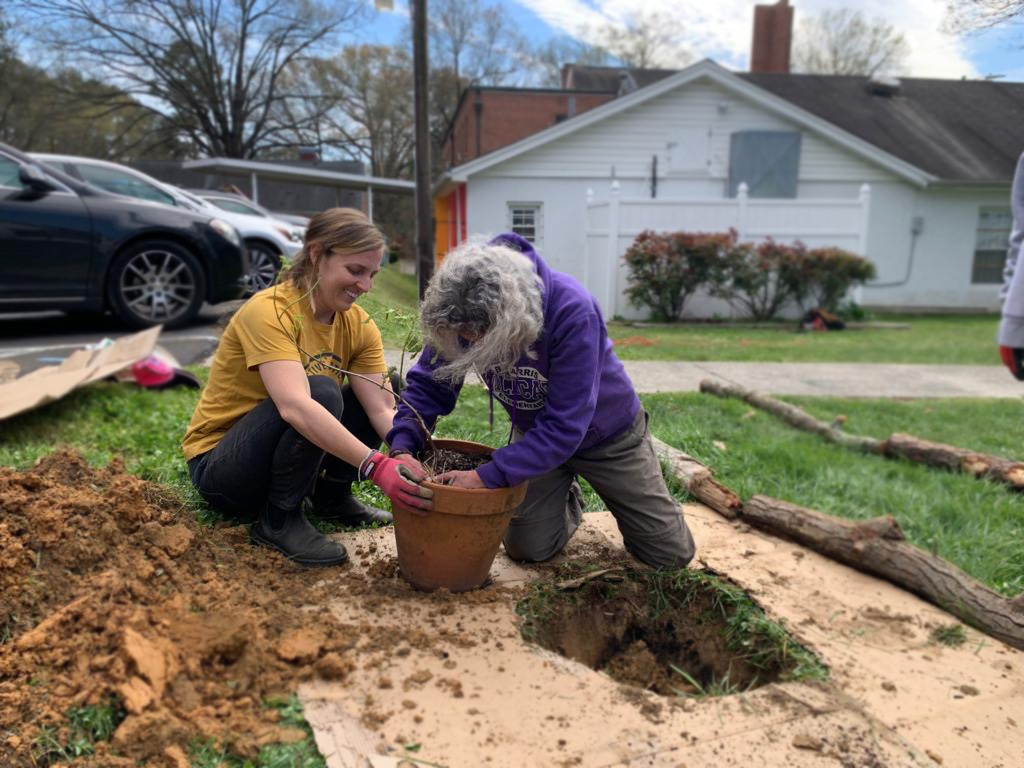Sharing the Lawn
Sharing the Lawn
By Kelly Dunlap
Several years prior to the COVID-19 pandemic, community members in Durham, North Carolina gathered to learn about injustices in the city’s history and to organize for a more equitable future. When the pandemic hit, the group asked how, together, they might tangibly support their neighbors. They created North Durham Mutual Aid and began outreaches like “free markets.” While brainstorming other potential neighborhood resources, one of the organizers suggested a community garden.
As they began investigating properties around town where they might grow a garden, an organizer thought of the large lawn at the church across from her house. The organizer already knew Rev. Casey Mursten, pastor of St. Paul United Methodist Church, so she approached her with the idea. Casey was excited by the prospect and invited the team to take the idea to the church council.
The organizers presented the council with their proposed map of the garden and community-building vision. The church council wanted to know it would be well maintained and the long-term plan for the space. After a productive discussion, the council voted to let the organizers use the yard space for the garden, free of charge. While the church would not take the lead in maintaining the garden, several church members with an interest in gardening – or merely a passion for connecting with the community – decided they’d roll up their sleeves and get involved by attending the monthly workdays.
In late 2022, neighborhood and church volunteers began planting. The garden, which they named Neighbors Growing Together, was given wide paths so it would be accessible to those with mobility aids. It was designed as a permaculture food forest, meaning it would be low maintenance and sustainable, and produce edible perennials. Trees – including a walnut and a persimmon – and seeds were donated by community members. In its first year, the gardeners have tended to the trees and grown flowers, strawberries, and more.
Rev. Casey sees the garden’s presence on the church property as spiritually significant. She chose to host their Easter sunrise service in the garden as she preached about Christ as the gardener and their call to be co-creators with God. She also sees alignment between the garden’s mission – provision in response to needs, environmental sustainability, and genuine relational connection – and her church’s mission. While the coordinators maintain responsibility for the garden’s upkeep, she happily goes out to water the garden as needed. She feels invested in its success: “I want it to flourish.”
The idea of putting the church property in service to the neighborhood is not a new one to this worshiping community. They have a “village playground” – the only greenspace in the neighborhood – and basketball courts that are open to the public. They have also operated a music venue for local artists in a small building on their property for 15 years. Still, when approached with the garden idea, Rev. Casey saw an opportunity for even deeper connection, and a project in harmony with the church’s theology and values. “When they came to us with the idea, I thought: We can’t pass this up.”
Operating an initiative with no religious affiliation on religious property has the potential to produce tensions, and it was a factor discussed by the organizers. One organizer explained, “Ultimately, we felt comfortable using the space because Pastor Casey was explicitly welcoming of those who might not feel comfortable in a religious space – such as those who hold different or no religious beliefs, and members of the LGBTQ community.”
Rev. Casey is grateful for the ways the garden has strengthened relationships between the church and neighbors. “When you have your hands in the ground, walls come down and conversations happen,” she says.
The organizers have big dreams for the garden. They hope to grow the garden so they can share the harvest with those who are food insecure, while continuing to provide a safe place for neighbors to connect. One organizer hopes that it can serve as a model for similar projects and that other small-scale, community-maintained gardens pop up on church properties around the city.
“It’s a great way for religious folks – who have this great resource – to interact with those who are non-religious,” she says. “It’s a beautiful collaboration.”
This story is part of Lake Institute’s story collection, the Faithful Generosity Story Shelf, which highlights congregations and other religious organizations who have sought to use their assets and resources in creative—and sometimes surprising—ways as an expression of faithful giving.
Each entry in our Story Shelf is short enough to be read and discussed during a committee meeting or other group gathering. Our hope is that these accessible vignettes will spark new questions, conversation, and imagination among clergy and laity about what might be possible with the funds, buildings, land, and other resources in their care. If you know a story that should be included in the Story Shelf, suggest it here.
Subscribe
Insights, a bi-weekly e-newsletter, is a resource for the religious community and fundraisers of faith-based organizations that provides:
- Reflections on important developments in the field of faith and giving
- Recommended books, studies and articles
- Upcoming Lake Institute events

